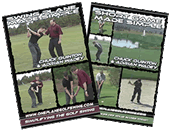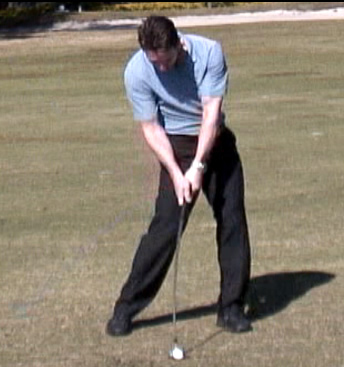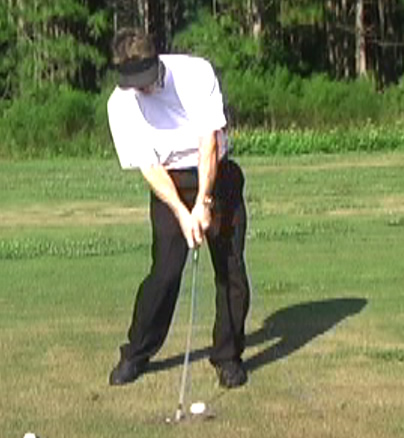by Chuck Quinton
Properly Fit Golf Equipment |
Rotary Swing Golf |
|
Properly Fit Golf Equipment Properly fit golf equipment is very important to everyone's golf game, not just professionals. Much has been discussed about the importance of properly fit shafts, but little has been done to show what happens when bad equipment happens to good golf swings. Below, I have a pic showing the dangers of playing shafts that are too soft for your swing next to a club that has been properly fit to my swing. Understand that tempo and how you load the shaft has a dramatic impact on the shaft, not just swing speed, so even if you have a slower swing speed, it is still very important to have properly fit clubs. If you load the club aggressively during the transition and early in the downswing, you will likely need stiffer shafts. If your swing is smooth and you don't load until late in the swing, you can get a way with softer shafts. If you have converted over from a two plane to a one plane swing, it is quite possible that you need stiffer shafts because the transition tends to be much more assertive in a one plane swing.
There is a lot to be said about feel when it comes to shafts, I prefer the feel of softer shafts simply because they provide more feedback, but I have to play stiffer shafts because my swing characteristics and how I load the shaft. Below is a picture of me hitting a 7 iron that turned into about a 9 iron at impact because the shaft is too soft (5.8 Rifle - a typical "Stiff" shaft). In my swing, I load the shaft somewhat aggressively and when you do that with a soft shaft, you can be in trouble if you don't smooth out your tempo. A shaft that is too stiff will also have detrimental affects to your swing as it the lack of feel and feedback will tend to cause the golfer to get "quick" and speed up their tempo and transition in an effort to load the shaft.
The shaft in a golf club loads and unloads throughout the swing. That is important to understand, it doesn't just load during the downswing and into impact, it loads and unloads throughout the entire swing. In the photo on the left of a shaft that is too soft, you can see that it is actually bowing forward at impact, so much in fact that the lower part of the shaft is actually pointing slightly backward, literally adding loft to the club at impact. The handle is pointing in the exact opposite direction, pointing several inches behind the ball while my hands are actually forward of the ball. As you can imagine, my sense of the club and feel for the shot would be completely lost if I tried to play with these clubs and I have very little chance of playing good golf with poorly fit clubs because I would have to alter my swing to fit the shafts. Of course, I could change my swing, to load the shaft later in the swing to fit the club, but that, of course, is the wrong solution. Get clubs to fit your swing, don't fit your swing to your clubs.
The shaft caused me to feel like I needed to "wait" on the clubhead to catch up. My arms and hands slowed down to allow the clubhead time to catch up, which only exasperated the bowing of the club forward. The shaft on the right is 6.8 S300 True Temper Dynamic Gold. Essentially, it is one whole flex stiffer than the Rifle, and it makes all the difference in the world. Because I don't sense the clubhead lagging a great distance behind my hands, I don't feel the need to "wait" on the club, which completely alters my timing and entire golf swing, which has been nearly exactly the same for the last 12 years!
Do yourself a favor this year, take a lesson with a sound instructor who can help you develop a simple and repeatable swing. Then go and get yourself dynamically fitted for a set of clubs tailored to you. Before having a set built, go to a builder who has dozens of demos that you can borrow for several days and play with them. See which one allows you to make a swing with the least amount of effort and "feels" right to you. It's important that you demo clubs before building an entire set because your swing can and will change depending on the club you swing. If it's too stiff for you, you will feel the need to be quick with the shot and not have the right amount of feedback from the club. If it is too soft, it will feel sloppy and loose and you will make other adjustments in your swing to compensate. The game is challenging enough without having to make compensations for poorly fit equipment. After you have found the perfect flex and overall club weight, length, etc. for your swing, take all that money you've been losing to your buddies every Saturday and have an entire set of irons built by a master club builder. It is important to have someone build your clubs who understands how to keep the flex and swing weight constant throughout the entire set of irons. It does you no good to have a 5 iron built perfectly for your swing and a 4 iron that feels like a board and a 6 iron that feels like a noodle. This is very common in a standard off the shelf set of clubs. The difference in flex throughout a set of clubs you buy off the shelf will absolutely amaze you. To give you an example, I bought a set of clubs off the shelf about 6 years ago that had graphite shafts because I hit them at a demo day very well and was so impressed by them. I bought them in what Callaway called "Regular Flex" as that was what I demo'd and I didn't want to feel like I had to "go after" each shot. After having trouble playing with the full set, hitting a 9 iron straight up in the air 140 yards on one hole and then hitting one 175 yards on the next, I decided to go see a club fitter and have them checked out. At the time, I didn't know much about club building and didn't think I needed a custom fit set. After seeing the actual specs on my new Callaway's, I was shocked, no, disgusted, to find that they ranged from 3.7 in my 3 iron (an A or Amateur flex) to 2.7 in my wedge, a Ladies flex! Needless to say, I was done with graphite and done with buying clubs off the shelf. I quickly realized I couldn't afford NOT to have my clubs custom built and you can't either. On the plus side, I could hit my pitching wedge about 170 yards, I just didn't know WHEN I was going to hit it 170 yards. Save some money and get yourself fitted this year, it will make a difference in your golf swing and your scores.
The shaft on the right is bowing slightly backwards just after impact, but it is not dramatic. If this frame was actually of the moment of impact, it would be bent back a bit more, but for this frame, it is ideal. If it flexes back too much it alters the loft too much and and can leave the clubface open at impact if it twists as well. If it flexes forward, it will add loft and can cause the clubface to close. Needless to say, you don't want to be making adjustments for either one of these equipment issues.
copyright 2006 Quinton Holdings |
|||
|
|
|
|
|
|





